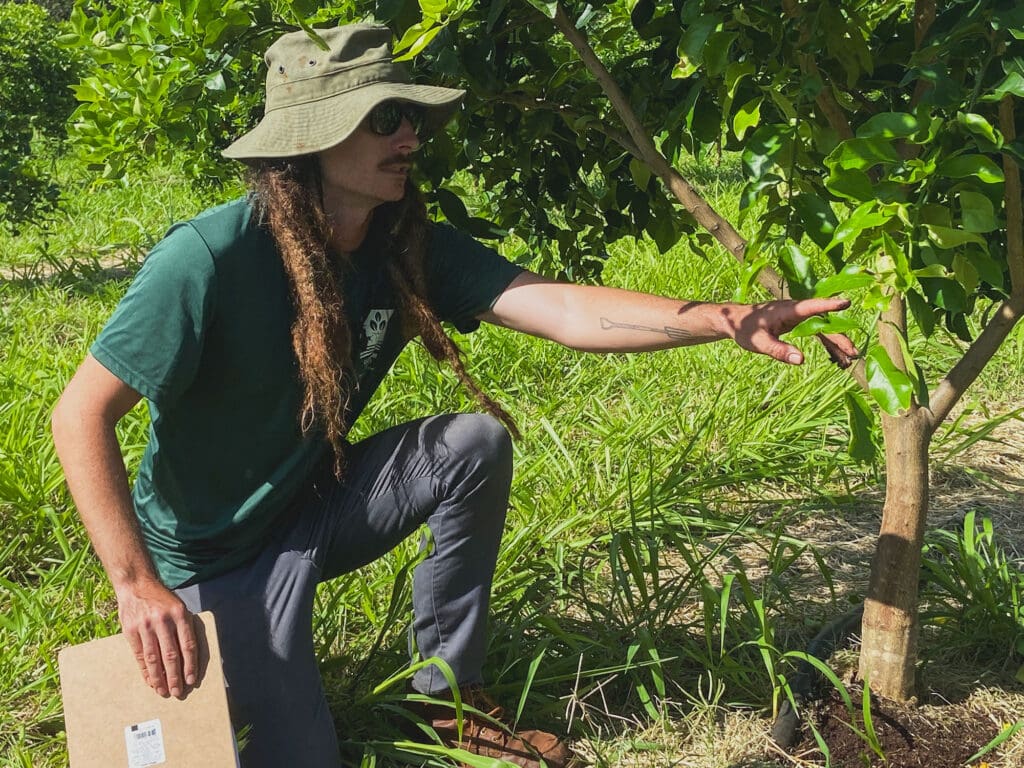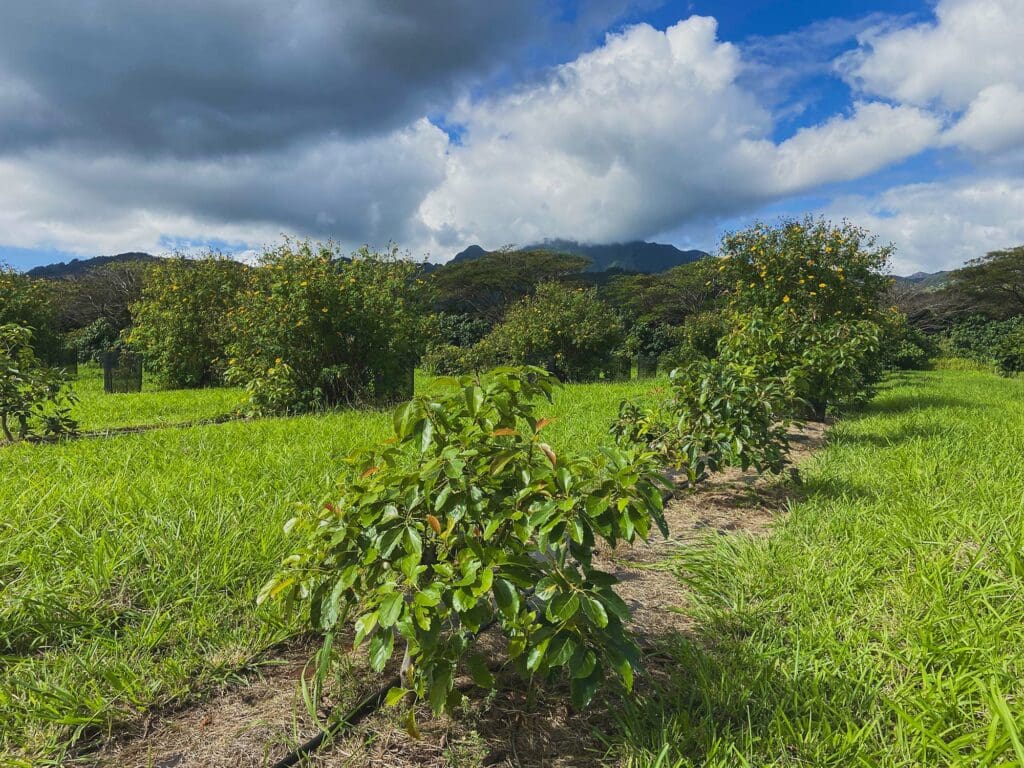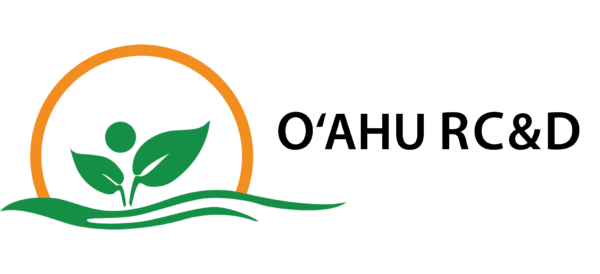Windbreaks, Strip-tilling, & More
Soil Health Practice Demonstration
at Hua Orchards
Operation Background:
Remy and Daniel Carroll are the owners and operators of Hua Orchards. After learning and working with Kahuku Farms and Barel’s Avocados, they were excited to secure a long-term lease to 30 acres on the North Shore of Oahu in Waialua and start their own farm. Separately, they have been growing avocados for Barel’s Avocados since 2013. Between the two farm sites, they now grow many varieties of avocados, Tahitian limes, as well as other tropical fruit and flowers using organic and regenerative farming practices.
In 2019 they began to prepare their new land, which was previously used to grow corn and sugarcane. They were eager to move the fallow land into production, using regenerative practices to restore soil health and function and the greater on-farm ecological system. One of their first management challenges was addressing soil compaction and activating biology in the soil. After breaking up the subsoil layer, they immediately planted two rounds of cover crop mixes, using Sunn Hemp, Buckwheat and White Clover to add organic matter and diversity into the soil.
“We underestimated the challenges that wind poses to soil health.”
Daniel Carroll, Co-Owner/Operator, Hua Orchards

Resource and Production Priorities:
Wind
When Daniel and Remy started to work with their land they were aware of their wind exposure. However, they had underestimated the challenges that wind poses to soil health. The heavy winds made it difficult to maintain adequate soil moisture and a desirable evapotranspiration rate.
“We’ll be planting our avocado tree rows in blocks. Our new windbreak will be around the perimeter of these blocks. We also had overlooked the critical role your windbreak plays in creating a microclimate. Learning from this observation, we don’t plan to install the avocado for our next orchard until the microclimate is established from our windbreak. We plan to create the microclimate not just through our windbreak but also through intercropping with Papaya for at least the first few years. We’ll get a quick return on Papaya and have a marketable crop we can work with until we’re able to plant our avocados.”
“For our citrus orchard we did three rounds of cover crop and we disced the whole field. We plan to prep our avocado orchard differently, ” Remy reflected. “Instead of opening up the whole field, we’re going to strip till only where we plan to plant our trees. This will be a better approach to address the challenges with wind that this site faces. We also plan to install windbreaks a lot closer. We planted a beautiful windbreak of mahogany, a’ali’i and other natives, but it doesn’t protect our tree crops as much as we’d like, because it is so far away.”
Costs
In addition to the wind impacting their cash crop, it also created a prohibitive cost to establish cover crop in their particular conditions. “With the price of water being so low, we hadn’t thought that our irrigation bill for our cover crop would be a concern,” Daniel commented. “But it costs us close to $6,000 to cover crop.” After participating in the Know Your Cost to Grow training program, Remy has begun to track the cost to install their citrus orchard. Although she did not originally account for the cost to cover crop their orchard, she is now analyzing their irrigation bill and associated labor costs to figure out how they can make cover cropping more affordable.
At the beginning, Remy and Daniel were eager to get trees in the ground and were successful at establishing a ground cover of perennial peanut and clover. However, this success was short-lived as the hot summer and high winds caused their ground cover to die back.
In hindsight, they realized that they could ‘get further, by going slower’.
They are excited to apply what they learned from installing their citrus orchard as they prepare the land to plant their avocado orchard. Some of the practices they’ll be using to establish the avocado orchard include a wind break and cover cropping system, strip-tilling, intercropping and Integrated Pest Management (IPM). They aim to save on the installation costs and maximize the synergistic benefits of these practices by timing when they apply each one and working with the weather patterns and conditions.

Soil Health Practice:
Perimeter and In-Field Windbreaks
Since being on the land, Daniel and Remy have observed that wind is a major management concern and must be addressed to maintain soil moisture levels, reduce evapotranspiration rates and manage soil temperature levels. They are actively designing a windbreak and cover cropping system which will help them establish a microclimate and save money on their irrigation bill. This includes installing in-field windbreaks, mainly using Mexican Sunflower (Tithonia diversifolia) and other plant species that contribute to managing pests. They will also put in a windbreak around the perimeter of the blocks in their new avocado orchard using several varieties of fast growing clumping bamboo. Species were selected because they are fast-growing, provide uniform top-to-bottom coverage and are a resource readily available from a neighboring nursery business.
Daniel and Remy’s soil health goals for this practice are to reduce wind stress on the crop and topsoil, improve soil moisture retention, reduce evapotranspiration, and reduce soil temperature during the hot summer months.
Installation of the windbreak began in the Spring of 2022 along the perimeter of blocks measured out for their future avocado orchard. To prep the orchard for planting, cover crop will be planted during the wet season once the weather patterns start showing a consistent pattern of weekly rain. The mix will likely include Sunn Hemp and Buckwheat, but they may also experiment with some drought tolerant species.
Strip Tilling
A strip-tilling system will be used to prepare the field for establishing the new avocado orchard. Tilling just the tree rows and leaving the rest of the field covered will help maximize soil aggregate stability and maintain soil moisture levels.
The field will be strip-tilled prior to planting their cover crop.
Long-term Cover Crop
Remy and Daniel will install long-term cover crop using perennial peanut and white cover planted within the rows of their citrus trees. The hope is to establish this perennial cover crop to keep the ground covered, reduce weed pressure, and to provide a source of green mulch for their trees. They would also like to explore alley cropping, by encouraging the perennial peanut and clover to establish in the pathways between their citrus tree rows. The pathways are currently guinea grass and maintained with a zero-turn mower.
They plan to install this practice in their citrus orchard in the wet season of 2023, allowing three years from when they planted their citrus trees in late 2019. This time is needed to allow their trees to grow large enough to provide adequate shade for the perennial peanut and white clover.
Integrated Pest Management (IPM)
Daniel and Remy have underway an IPM strategy to help them manage any pests that may become an issue. Plants selected for their windbreaks, cover crops, perennial ground cover, and used in their inter-cropping system will help manage pests and disease of their cash crops. They are currently experimenting with Mexican Sunflower (Tithonia diversifolia) and many other pollinating species. They plan to continue researching plant species that either serve as ‘trap crops’ for pests, attract beneficials, or help deter pests.
To protect their avocado crop, they are working with plants that host the Lace Wing, which is a predator of the Lace Bug pest. They may also try cover cropping with mustard or daikon to receive the biofumigation properties against plant-parasitic nematodes.

Monitoring and Updates:
Check back for updates on the results of Remy and Daniel’s soil health practices.
Note: This material is based upon work supported by the U.S. Department of Agriculture, under agreement number NR2192510002C002. Any opinions, findings, conclusions, or recommendations expressed in this publication are those of the author(s) and do not necessarily reflect the views of the U.S. Department of Agriculture. In addition, any reference to specific brands or types of products or services does not constitute or imply an endorsement by the U.S. Department of Agriculture for those products or services.
Resources and References:
- Bamboo as an Alternative Windbreak
Oahu RC&D and partners explored the viability of using bamboo as a windbreak in Hawaii. Several different bamboo species were identified as excellent multi-purpose plants that are non-invasive, wind-resistant and rapid-growing, with results indicating Bambusa heterostachya, Bambusa oliveriana and Bambusa lako among the best species for rapidly establishing windbreaks on Oahu. - Cover Crops and Green Manures
Visit this page for a wealth of information about cover crops and green manures, including crop selection information and various studies. - Strip-till cover cropping and vermicompost extracts improve soil and plant health in a short-term vegetable cropping system
This study by CTAHR’s Archana Pant, Koon-Hui Wang and Theodore J.K. Radovich concludes that combining the practices of strip tillage, cover cropping with sunn hemp, and applying compost tea in addition to baseline organic fertilizer application can help enhance the abundance of beneficial nematodes involved in soil nutrient cycling, suppressing plant-parasitic nematodes and improving crop yield in a short term vegetable cropping system. - Strip Till Cover Cropping
These CTAHR slides outline the steps and advantages of strip-till cover cropping, plus an additional method called row switching.

